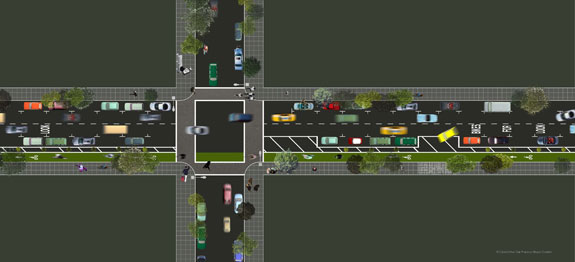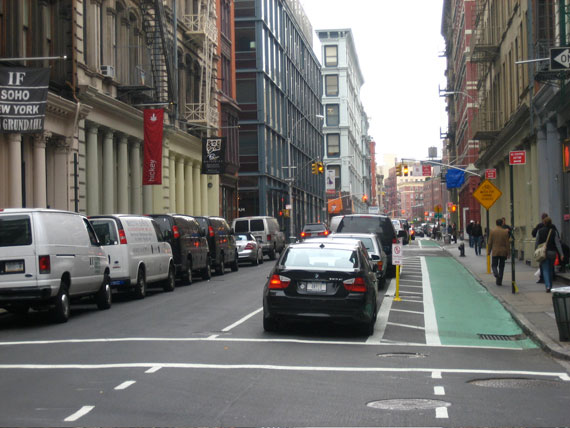
Mayor Ed Lee's comments to Streetsblog earlier this week that he would like to "quickly" see a physically-separated bike lane trial on Fell Street along The Wiggle came as exciting news to bicycle advocates who are proposing a continuous green stretch along the curb from Scott to Stanyan Streets.
"I want to get to that experiment on Fell Street quickly because I’d like to see how these lanes that we are dedicating would be away from the open doors, and away from fast traffic," the Mayor told Streetsblog.
Both Fell and Oak, which run adjacent as one-way arterials, present an ideal opportunity to build San Francisco's first parking-protected bike lanes, and to begin restoring some of the safety and civility the neighborhoods knew before traffic engineers began turning the quiet streets into residential freeways.
"We're encouraged to hear Mayor Lee's interest in making Fell Street safer and more inviting for everyone, and look forward to working with the city to help get this bikeway on the ground," said SFBC Executive Director Leah Shahum."Creating a physically separated bikeway on both Fell and Oak Streets will be essential to connecting our city with safer streets and helping more people of all ages to feel comfortable and confident biking."
Bicycle advocates have urged the SFMTA to experiment with a physically-separated lane on Fell Street, especially on the three blocks of Fell between Scott and Baker. Those blocks currently connect the popular Wiggle bike route with the multi-use Panhandle Park path for points further west, as well as connections north and south.
Cyclists cite the ongoing hazards of traveling along fast-moving traffic and maneuvering around vehicles that fully or partially block the bike lane, especially at the entry to the Arco gas station at Divisadero. Although car and bicycle traffic moves more smoothly through that area since the SFMTA installed new lane configurations, difficulties remain. Bike riders also have to watch for car doors swinging open on other portions of Fell.

Despite those conditions, the route has become very popular since being striped over a decade ago, because it is a major east-west connection. Ridership has nearly doubled on that portion of The Wiggle in recent years. According to the latest SFMTA data, 52,055 people rode on Fell Street between Scott and Divisadero last September. Most of those rides took place in the evening commute hours, when the street is busiest and the bike lanes are most often obstructed.
The very popularity of the route has caused some consternation among other users of the Panhandle Path, especially older pedestrians and parents with young kids. Fast-spinning bicyclists and walkers easily get in each other’s way and conflicts appear regularly on the narrow mixed-use path. In this case, non-bicyclists are becoming strong supporters of a separated bike lane on Fell, if the new facility reduces fast bike traffic on the multi-use path.
"A physically separate bikeway up Fell street would be a tremendous benefit to the Panhandle," said Jarie Bolander of the North of Panhandle Neighborhood Association (NOPNA). "Not only would it provide a safe way for bicyclists to commute east and west, but it also calms traffic and would make it more pleasant to stroll in the Panhandle. In addition, the Panhandle needs some major upgrades and this project is a great way to bring focus on those efforts."
The SFBC is urging the SFMTA to install green physically-separated bike lanes from Scott to Stanyan on Fell and Oak, acting as a couplet for bike traffic. The changes would look similar to the several blocks of green separated bike lanes on Market Street, but could utilize parked cars instead of soft-hit posts to separate vehicle traffic from bicyclists.
The SFBC proposes two options for addressing the safety problem. The first would be to remove the parking on the south side of Fell and the north side of Oak to permit space for bike lanes, using a design almost identical to the popular bike lanes on Market Street.
The alternative would be to keep the parking but convert the curbside space into a bike lane, reduce the number of lanes on Fell and Oak from three to two between Scott and Baker, and from four to three lanes between Baker and Stanyan. It would allow cars to park along the outside of the bike lane with a five-foot buffered space between the bike lane and parked cars.

It took a matter of days to install a similar treatment on Grand Street in New York, which now has 14.8 miles of protected bikeways, compared to less than a mile for San Francisco. The Grand Street lane is about a mile long and provides a crosstown connection leading from downtown Manhattan to the Williamsburg Bridge and Manhattan Bridge. The Fell and Oak improvements would be similar and just as easy to do.
The option to maintain parking is one that will probably be favored most by residents concerned about tight parking in the neighborhoods. It would also benefit people on foot because it could be accompanied by bulbouts and other pedestrian-friendly treatments at intersections, making it easier and safer to cross Fell and Oak Street.
The area is a prime location to experiment with the proposed design, which has also been successful in Vancouver and Portland. It also works well because there are generally few residential curb cuts and driveways along the proposed green bike lanes. In spots where curb cuts do exist, the bike lanes would become dashed.
The Arco station presents several complications, and any solution will likely yield less-than-perfect results, but advocates believe city officials can eventually get rid of the curb cuts at the troublesome location. For now, though, the SFBC's recommendation is to have the curbside bike lane become dashed where it crosses the curb cuts, and allow drivers to queue up in a left turn-lane on the outer side of the bike lane.
The city has recently shown more willingness to experiment with innovative projects and avoid the great-study-on-the-shelf syndrome. Mini-parks and parklets throughout the city have earned rave reviews among early skeptics and changes to lane configurations have always been a feature of traffic in the city.
The SFBC, neighborhood leaders, and other livability advocates hope – and urge – the city to adopt the separated bike lanes on Fell and Oak to improve safety and traffic flow for all road users.
This story is a collaborative piece from Streetsblog San Francisco and BIKE NOPA, a website that's "all about bicycling and livability in San Francisco's North Panhandle neighborhood."





